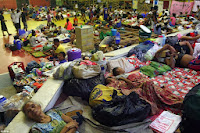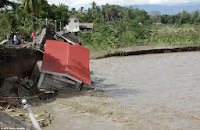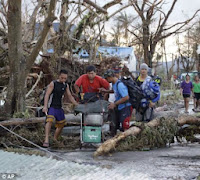The following executive brief of the proposal for funding for a housing project for Yolanda and future victims of calamities is shown below. It was also published in social networking site. See here.
The Post-Yolanda Housing Situation in the Philippines
A reported 300 Kph-strong, hurricane category 5 tropical cyclone hit the Philippines on November 8, 2013 and devastated a large number of areas located within nine (9) administrative Regions of the country.
The final report on the actual scientific and technical analysis and assessment of this natural phenomenon - its true levels of strength at various stages, identifiable patterns of emergence (if any), and other factors, will take some more time, however the situation on the ground of those that were affected by the disaster needs immediate attention.
Furthermore, also needing immediate and serious attention are the victims of calamities about to occur in the near future in the Metro Manila and surrounding areas. The Philippine Government itself, together with other sectors, have warned that the next big calamity will strike the national capital region itself. These bodes for measures to mitigate the atrocities and huge damages to Metro Manila similar to the ones suffered by the people in Visayas and parts of Mindanao brought about by tropical cyclone Yolanda.
 The Philippine Government, in cooperation with foreign donors has put in place a few stop gap measures to alleviate the conditions of the victims, 90% of whom had either totally lost their homes and valuables, with more than 50% up to a high of 75% also losing their very source of livelihood in the process:
The Philippine Government, in cooperation with foreign donors has put in place a few stop gap measures to alleviate the conditions of the victims, 90% of whom had either totally lost their homes and valuables, with more than 50% up to a high of 75% also losing their very source of livelihood in the process:
1. Crops (rice, coconut, corn, other primary agricultural resource)
2. Merchandise for retail, wholesale
3. Manufactured light products (paper based, light wood-based, water-based, others)
4. Real estate improvements (for rent space - building, house, etc.)
5. Others
 In the current situation, housing materials are being given by Raffle Draw to victims of the disaster. Twelve (12) pieces of new metal roof sheets are given to a few victims whose names are picked in a Raffle Draw at the level of the Municipality. Along with the 12 roof sheets are different sizes of nails. The metal roofs are marked with a foreign brand and are said to have arrived from outside the Republic of the Philippines. At this rate therefore, with the giving of roof sheets through the Raffle Draw it is envisioned it will take a considerable amount of time to service several hundreds of thousands up to millions of victims without any capacity to borrow money or generate new income to allow them to completely rebuild their homes and return to normal life and hopefully, as well to their livelihood.
In the current situation, housing materials are being given by Raffle Draw to victims of the disaster. Twelve (12) pieces of new metal roof sheets are given to a few victims whose names are picked in a Raffle Draw at the level of the Municipality. Along with the 12 roof sheets are different sizes of nails. The metal roofs are marked with a foreign brand and are said to have arrived from outside the Republic of the Philippines. At this rate therefore, with the giving of roof sheets through the Raffle Draw it is envisioned it will take a considerable amount of time to service several hundreds of thousands up to millions of victims without any capacity to borrow money or generate new income to allow them to completely rebuild their homes and return to normal life and hopefully, as well to their livelihood.
Eventually, the Philippine Government will come around towards extending support and assistance for reconstruction of destroyed houses, even for those that cannot afford to repay the cost over the long run, to have their houses rebuilt. This will have to be within a more immediate time frame, since as the victim families have stated, during the aftermath of Yolanda, everytime it rains they have to find trees, old walls of their destroyed houses and stand up to minimize catching rainfall then wait in one position until the rain stops.
Revival of Funded Project
An aborted project in Luzon with a fund of no less than Eighty Billion Philippine Pesos (PHP80-B) was due to be staged in more than two thousand five hundred hectares (2,500 has) of alienable and disposable real estate in the Municipality of Tanay, Province of Rizal with a resettlement housing and satellite resettlement communities in Real, Infanta, and Nakar – all in the Province of Quezon that will occupy an aggregate real estate size of more or less six to ten thousand hectares (6,000-10,000 has).
The project became possible with the preparation of a Project Pre-Feasibility Study that outlined the creation of s elf-sustaining communities in the vicinity of Eastern Metro Manila-Rizal-Quezon area also called Marilaque area. Said study was submitted to a foreign Funder that upon evaluation of the merits of the undertaking, approved the enterprise for an investment loan with very soft terms and conditions with an absolute value of United States Dollars Two Billion (USD2-B) in 1999. On record, the approval of the investment and necessary documentation to be accomplished and signed with the beneficiary (as represented in this project's case by the Philippine Government), were forwarded by the Funder to the Philippines.
The group that prepared the pre-feasibility study is a coalition of eight (8) independent organizations with the following as the lead entitites:
Centre di Humanes et Societas, Inc.
Center of Social Development Alternatives, Inc.
Development Alternatives – Asia Pacific, Inc.
The project was cut short merely due to a transition in government in the Philippines and His Excellency Jose Marcelo Ejercito also known as Joseph Estrada was replaced by then Vice President Gloria Macapagal Arroyo. The aborted project was spearheaded by the private sector (CDHS, Inc.), then was funded with more than 150,000 target beneficiaries represented by the Philippine Government receiving an investment by the funding agency with soft loan terms and conditions in the absolute face value of United States Dollars Two Billion (USD2-B) in 1999.
When the transition took place, the national leadership and the lead participating agency in the Philippine Government no longer took up from where the previous administration of Pres. Joseph Estrada left and the Tanay, Rizal resettlement housing was shelved. The fund for the project would certainly be taken out of its original prescripton in favor of the Philippine beneficiaries and will be returned to its original source or diverted to other investment fund beneficiary who needed it most.
Response to Current Human Settlement Issues
The determination of Fleurdelis Green Heights (A Concern of CyberparkGroup) with the CSR arm CDHS, Inc. is to revive the aborted project. Such revival will be with an increased scope and coverage. The full intention is to provide an immediate response to the post disaster settlements concerns in all the affected areas of the recent calamity, typhoon Yolanda.
The utilization of the original project site will still be considered, however, a change in the original project framework will be adopted to be tailored-fit to the potential of future natural phenomenon projected to occur within the vicinity of Eastern Metro Manila as well as the adjoining Provinces of Rizal and Quezon.
This change of the project plan framework will be done, notwithstanding that even if the site may not have been affected in any part by the Presidential Proclamation 226 of 24 November 2011 by His Excellency Benigno Simeon C. Aquino III declaring no less than 26,125.64 hectares of the Marikina Watershed covering the Municipalities of Baras, Rodriguez, San Mateo and Tanay, all of Rizal Province as Protected Areas, there will be a need to re-engineer the original design due to the weather factor and considering such other aspects of design engineering and geologic-seismologic, geospheric variables that inevitably must come into play in the vicinity of the Eastern Metro Manila and Rizal-Quezon Province area.
Shelter-Livelihood Hubs. As originally envisioned, the revived project will complimentarily focus upon building “livelihood hubs” to service several hundreds of thousands to millions families that lost their homes and are barely adequate enough to rebuild their homes.
For the aborted project in particular, the focal livelihood center was an integrated steel multi-industry complex. Steel works plant for dye and tool making, another for railroad construction, a site for shipbuilding and aircraft or military materiel manufacturing, also for frameworks for bridges, ultra-high buildings or towers and other super structures. The industrial complex shall provide training or capacity building and ultimately livelihood for thousands of people in the area who will be coming from various informal communities of Metro Manila. More > >
By:
Corporate Social Responsibility arm of CyberparkGroup
Some of the grim images compiled by the International Business Times London on the devastation by Yolanda, the state of the victims after the typhoon and some of the immediate responses.










































.jpg)






